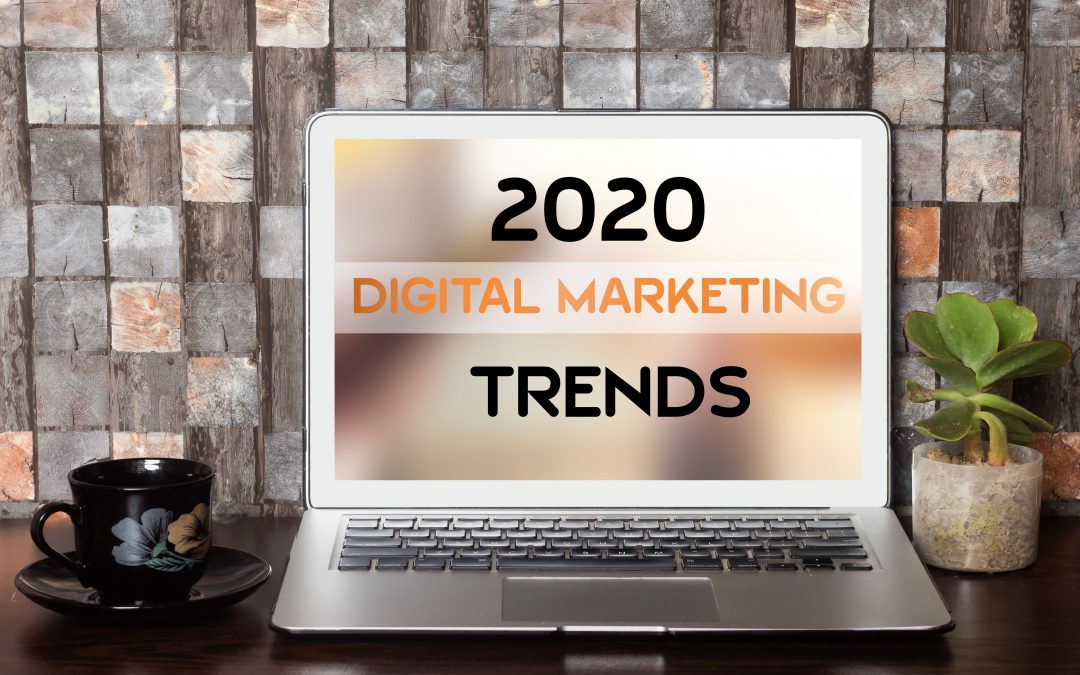
by Francois Muscat | Nov 5, 2019 | Digital Media Marketing
In digital marketing, trends change rapidly and non-stop. There is always some new technique, software, algorithm change or expert opinion to take into consideration. With the end of this year fast approaching, we’re looking at some important trends that digital marketers need to be aware of for the year to come.
The Top 5 Digital Marketing Trends for 2020:
Messaging Apps
With the introduction of Whatsapp for Business and similar features on messaging apps, digital marketing has found a way to become even more personal. Businesses can now manage a multitude of interactions through these apps, including digital marketing. The ability to create targeted groups, share promotions, host flash sales and bring a personal touch to all these messages is highly valuable to digital marketers, and we predict a steady uptake in using messaging apps for various digital marketing purposes.
Artificial Intelligence in Digital Marketing
Experts predict massive growth in the use of AI in managing the customer experience by implementing chatbots to drive targeted marketing interactions and manage customer queries. Chatbots can provide real-time feedback to questions without any delay or bias and in this space, they far outperform their human counterparts (who suffer from the normal side effects of being human).
Hyper Targeting
Companies investing in digital marketing expect to see results from their efforts. Hyper targeting turns customer insights into personalised messages to ensure that niche messages reach the correct audience, which improves the return on investment. It also creates brand awareness in the correct way by avoiding customers outside of the target market who may become brand-averse through repeated exposure to unsuitable messaging.
Content Marketing
It shouldn’t be news that content marketing is still a hot topic in digital marketing. The trends in this area are based on the type and format of content marketing. Interactive content and video content are set to take the lead in content marketing. These types of content are engaging, transparent and easy to digest. Consumption of live videos on social media is on the upswing as influencers and content creators become more comfortable in the medium, and consumers are actively seeking to engage with creators they follow in this space.
Shoppable Posts and AR/VR Experiences
Digital marketing meets online shopping in the advent of social media posts that link to e-commerce stores. The idea is to create a seamless experience by showcasing products, enabling the customer to try on the item (or view it in their own home) through AR/VR technology and simplifying the purchase process. Instead of looking at a digital catalogue, the virtual shopping experience is even closer to real life, and that is a powerful extension of digital marketing. Early adopters will be large retail brands due to the large investment it would take to implement virtual reality into the shopping experience.
The digital marketing landscape for the next year already promises great advancement, and we’re excited to discover trends that the industry might have not been able to predict yet. For more information on digital marketing trends for social media marketing, mobile marketing and email marketing contact us today.

by Francois Muscat | Nov 4, 2019 | Digital Media Marketing
Getting traffic to your restaurant can be simple and cost-effective – if you use digital marketing to your advantage. Digital marketing is a powerful tool in getting more traffic to your restaurant, but there’s more to it than posting a few images on social media and having a website. To increase the effectivity of digital marketing for your restaurant, we’ve gathered our favourite tips that you can easily implement in your marketing strategy:
Use Social Media for Your Marketing
Social media loves visuals and is the perfect medium to advertise your restaurant. Thanks to smartphones with great cameras, you can easily shoot high-quality images of your signature dishes, beautiful décor and helpful staff. Shoot some good-looking images, add your location (a function on most social media channels) and post it to social media. These posts will entice hungry clients in your neighborhood to drop by and experience your ambience. Don’t forget to add relevant hashtags to help your audience find you.
Bring Digital Marketing Home with Your Own Website
If your restaurant doesn’t have a website, it is basically invisible to a large number of people. In this digital age, a website will lend your restaurant credibility and will help potential clients to find valuable information (like trading hours, address and contact details) quickly. You need to invest some time (and possibly a little bit of money) in getting a website so you are visible on the digital map. A website also gives you a home for your content and can help you to connect with potential clients through a contact form or newsletter sign-up.
The most important aspects of a restaurant’s website? It should load quickly and be easy to navigate. Keep it simple and stick to your brand.
Use Content Marketing to Set Your Restaurant Apart
Content marketing takes the approach of educating or stimulating interest instead of explicitly promoting a product or service. Experiment with creating a blog to showcase inspiring recipes, give tips on seasonal ingredients and educate your followers on topics related to your industry.
Make the most of special events and holidays to create highly shareable content. This can include special cocktail recipes for Christmas or New Year, yummy cookies for the school holidays and food-related crafts your followers can make with their kids.
If you want to outsource your content marketing, why not collaborate with local bloggers or personalities? Offer incentives and set-up ways to post each other’s content that will be beneficial to both parties.
Get Listed, Everywhere
Make use of the myriads of business listing platforms and focus your attention to platforms specially created for the restaurant industry. You want your restaurant to appear on every possible listing website, restaurant app and local entertainment guide.
We have some fantastic resources that will educate you on the various facets of digital marketing. So, if you’re ready to learn more, visit our blog at http://www.blog.wsioms.co.za/.

by Francois Muscat | Oct 28, 2019 | Mobile Marketing
Text message marketing is a great way to gain visibility in front of your loyal followers and customers, but how do you do it? What’s the best way to take advantage of text message marketing to grow your business? And, furthermore, why text message marketing over email?
We get that question all the time! And the reason is that text message marketing gets in front of people instantly, and basically, everybody sees it. With email, there’s a little bit more of a delay because people don’t check their email in real-time. In this blog, we’re going to give you examples of how you can use mobile marketing to make your brand stand out.
1. Include Calls to Action on Your Website
For an e-commerce store, a good text message marketing campaign might be something like an instant coupon. Maybe somebody is on your e-commerce store, they’re on the check-out page and you have a lot of abandoned carts and you want to try to reduce that. Put a call to action on the page: “Hey, opt in to our text message campaign right now and get an instant coupon for 20% off.” This helps customers move forward through the buying process.
2. Give People the Information They Want
A dance studio has classes and scheduling. Maybe classes need to move out due to bad weather. This would be information that would be super important to get in front of people in real-time. Email wouldn’t be as effective here, right? Text is much more effective if the class was cancelled because of a heatwave or a big traffic pile up, for example. In this case, people will be grateful to get a text message because it gives them important information they need to plan their day.
3. Offer Worthwhile Specials and Deals
A restaurant is another great example. It’s a slow day on Tuesday at lunch, right? Instead of just sitting there with a slow day, you can send a text message out to the loyal followers of your restaurant and tell them there’s a buy-one-get-one-free burger deal or 30% off lunch menu items, for example.
4. Make Sure You Have Permission to Text
With text message marketing, you can’t just put somebody’s phone number into a text message marketing software programme to text them. That’s against the rules. They need to actually opt-in to receive the information that you want to provide. So, what you need to do is think about where are you going to get this call to action out in front of people. If you own a restaurant, this should be in-store, on the table or on the menu. If you have an email subscriber list, consider including the option to opt-in in a newsletter.
Need help with your mobile marketing, content marketing or SEO? Then contact WSI OMS today.

by Francois Muscat | Oct 23, 2019 | SEO
SEO efforts have largely been concentrated on Google – and with good reason. The search engine has exerted a nearly unshakeable dominance for a long time, and its grasp on the lion’s share of the market doesn’t seem likely to loosen soon.
However, over the past year or so, other search platforms have started to increase their share of the world’s searches. According to 2016 figures, Google still holds over 60% of the market. Bing comes in second with around 33,5%. In the specialised area of product searches, Google faces a very real threat in the form of Amazon. According to the same research, a third of online shoppers go directly to Amazon to find their products, rather than starting with Google. In 2016 alone, Amazon product searches saw a 73% growth. In the years since then, the online retailer’s growth has continued.
Apple has also thrown its hat into the ring, and continues to increase its strength in the fight, despite its market share being considerably lower and more niche. Then there’s also Facebook and WhatsApp to consider.
Google still dominates the search engine market. But, what do these very credible challengers for the crown mean to us as SEO marketers? The short answer is that it may be worth taking them into account with your SEO strategies, and leveraging the smaller, more targeted audiences of these engines to achieve your marketing aims. Here are some key points to work into your strategy:
- The algorithms that operate Bing (as well as other search engines like them) are not as complex as those of Google, which means they require a little more work. However, if you put in the extra effort, you can build your rankings quite nicely. You need to be both more targeted and more specific, but this will quickly move you upwards in the rankings.
- Google does not take meta keywords into account for its rankings. Other search engines still do. This means that if you include relevant keywords, along with all the combinations of synonyms and misspellings that could lead to your site, you can work your way manually to the top of the rankings. Your efforts in this area could distinguish you from your competition.
- Google uses Latent Semantic Indexing to rank web pages. This allows you to hit the SEO marks without always having to use the exact keywords on your page. With Bing and the like, you need to be more specific and accurate with your choice of on-page keywords. Always place the keyword in both the h1 and h2 headings and write strong meta descriptions that also include the precise keywords you have chosen.
- DuckDuckGo is an increasingly popular search engine due to its emphasis on user privacy. To build your presence on this platform, you need to focus on strong link building. Also, link back, as often as possible, to high-quality sources with a high trust and recognition factor. Wikipedia is one example of a source that has DuckDuckGo’s trust.
- Google does not like flash websites – those built with Rich Internet Applications (RIAs). This means that content from these websites does not get indexed on Google. Bing is absolutely fine with these websites, however, which means you won’t get sidelined if your site(s) makes use of RIAs. However, your primary RIA data still needs to be readable to make a difference to your rankings, so you may want to include a text-based description to help the bot out.
So, why would you want to go to all this trouble when Google is bigger and faster? Well, no investor ever puts all their money into a single fund. They offset risk and facilitate growth by diversifying their portfolios. Doing the same with your SEO strategy could reap dividends too. Particular sectors and niches can be targeted more precisely and narrowly on search engines such as Bing, which would enable you to reach more of the right audience for your business. Industries that can be targeted especially well through Bing include education, telecommunications, business and finance as well as travel and retail.
While Google will almost always help get more traffic, other search engines might just bring you better traffic, depending on your business and target market. Why not give them a try?
WSI OMS are experts in SEO. Contact us to discuss your SEO strategies, and how you can perfect and future-proof them.

by Francois Muscat | Oct 21, 2019 | SEO
By its very nature, SEO is a competitive sport. You’re not working alone in a vacuum to improve your search result rankings; you’re working to do better relative to your competitors. Improving your rankings is a delicate balancing act because you need to be able to keep your head down and constantly focus on improving your own content and SEO strategies, while at the same time, keeping an eye on what your competitors are up to. You should never devote too much or too little time to one or the other. Here, in order of priority, are the most important things you need to do to improve or maintain your rankings:
• Always Work to Perfect and Increase Your Content
Both quantity and quality of content are essential to attracting visitors to your site. Keep your eye on the ball and keep honing your content to a fine point, while also building up its scale. Remember that, at the end of the day, search engines reward great content.
• Rethink Your Keyword Strategy Constantly
This is the frontline of your attack, so to speak. You need to do your research and use a more responsive approach. Focus on search queries that yield the highest total traffic. You may want to push keywords that remain effective, while allowing lower-ranking ones to slip to your competitors. Check the traffic data regularly and adjust accordingly.
• Watch the News
While focusing on your content and monitoring keyword traffic fluctuations, also watch the news and trends in the field of SEO. This is a growing and shifting field, with new insights and techniques being added all the time. Read blogs like this one, consult with SEO experts and use the information to sharpen your tools.
• Watch What Your Competitors Are Doing on Their Sites
Visit your competitor’s websites every day. If you notice a change in their SEO activities, you should definitely dig deeper. Take a look and see what the changes are doing to their search rankings. Maybe they’ve hit on a new optimisation technique. See how you can adjust your activity accordingly.
• Monitor Your Backlink Profile – And Your Competitors’ Too
Negative SEO activity can destroy your rankings and strategy. And, by checking up on your backlink profile, you can monitor whether or not this has become a problem for you and take appropriate action.
When it comes to your competitors, check out their backlink profile to see if you can pick up on any new linking partners and strategies that they might be using to get an edge on you.
While you shouldn’t spend too much time away from your own creative endeavours, it pays to be alert and fully aware of what is going on elsewhere in the field in which you’re playing.
WSI OMS can help you plan, execute and monitor competitor-beating SEO strategies. Contact us to discuss your digital marketing objectives.






